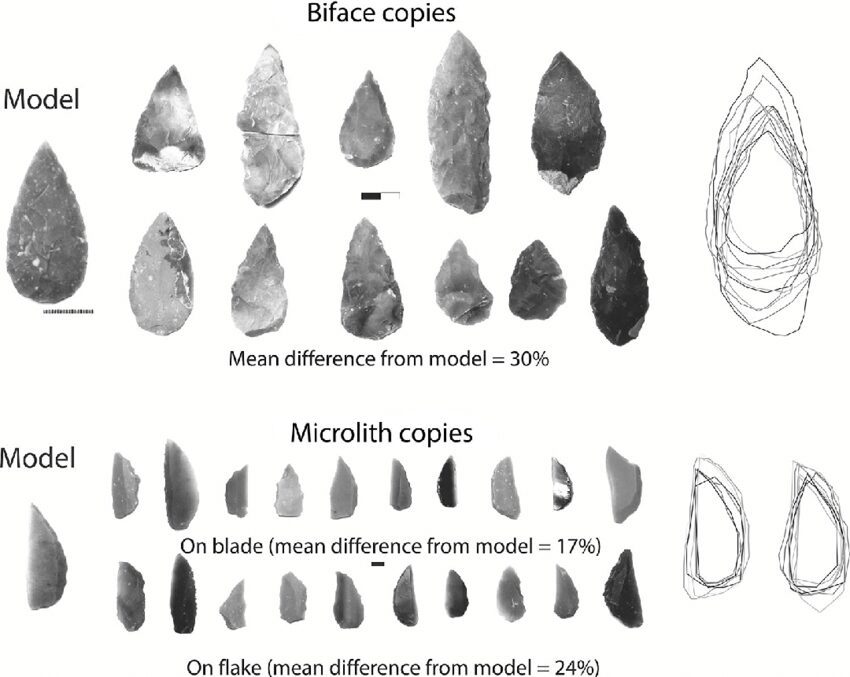October 24, 2025 4:26 pm

Prehistory: Understanding the Unwritten Past
Prehistory refers to the period of human history before the advent of written records. Since history, by definition, relies on written sources, prehistory is essentially the study of the time when human beings did not yet use writing. This era encompasses the earliest periods of human development, including the Stone Age and the early stages of human civilization.
Prehistoric sites in India differ markedly from historical sites. While historical sites often include prominent structures such as cities, temples, or inscriptions, prehistoric sites are generally characterized by the remains of fossils—both human and animal—along with plant fossils and stone tools. These sites offer a glimpse into the lives of early humans, as well as the environment in which they lived.
- Location of Prehistoric Sites: Prehistoric sites are typically found on the slopes of plateaus and mountains, often near river banks or in regions with terraces. These geographical locations were favorable for early human settlement, as they provided natural resources such as water, food, and raw materials for tool-making. The presence of diverse fauna and flora at these sites suggests that early humans adapted to a variety of environments, hunting animals and gathering plants for sustenance.
- Stone Tools and Evidence: One of the most significant archaeological findings from prehistoric sites are the numerous stone tools, which provide evidence of early human activity. These tools date back to the Stone Age, a period during which humans developed basic technologies for survival. The remains of animals, plants, and humans at these sites help reconstruct the climatic conditions and the lifestyle of early humans.
- Climatic Conditions and Environment: The fossils and tools found at prehistoric sites give insight into the climatic conditions of the time. For instance, pre-ice age remains indicate that early humans lived in environments that were significantly different from the climates we know today. By studying these remains, archaeologists can infer the evolution of early humans and their adaptation to changing environmental conditions.
Proto-history: The Transition from Prehistory to History
While prehistory refers to the time before writing, proto-history refers to the period when societies had developed complex cultures but had not yet mastered writing, or when writing was present but not fully understood or deciphered. Proto-history acts as a bridge between the prehistoric and historic periods.
- Harappan Civilization and the Indus Script: One of the most significant proto-historic cultures in India was the Indus Valley Civilization, which flourished around 2600-1900 BCE. The Harappans are known to have used a form of writing, but it has not yet been deciphered, leaving historians with a limited understanding of their society. As a result, the Harappan culture is often placed in the proto-historic category. Despite the presence of writing, the lack of a comprehensive understanding of the script means that this civilization remains in the proto-historic phase.
- Chalcolithic or Copper-Stone Age Cultures: The Chalcolithic period, or the Copper-Stone Age, is another example of proto-history. During this time, early societies began to use copper tools alongside stone implements, marking an advancement in technology. However, these societies did not yet have writing systems, placing them between prehistory and the historical period.
- Proto-history as a Transition Period: Proto-history is often described as the transitional phase between prehistory and history. During this time, some cultures or civilizations had not yet developed written records but were already noted by neighboring societies in their own written accounts. These records, although not from the culture in question, serve as crucial sources of information for understanding proto-historic societies. For example, although the Indus Valley script remains undeciphered, other cultures such as the Mesopotamians and Egyptians may have had some knowledge of the Indus Civilization, as reflected in their writings.
Proto-historic Societies and the Development of Writing
The development of writing marks the beginning of true history, as it provides a means of recording events, laws, and cultural practices for future generations. In India, writing emerged in the third millennium BCE, primarily associated with the Indus Valley Civilization. However, the inability to fully decode the script means the Harappan Civilization is placed in the proto-historic phase, even though they had a form of writing.
- The Emergence of Decipherable Writing: The first fully decipherable writing in India came much later, with the Ashokan inscriptions in the third century BCE. These inscriptions, written in Prakrit and Aramaic, marked a significant turning point in Indian history, providing the first solid evidence of historical reconstruction. These inscriptions not only provide valuable historical data about the Mauryan Empire but also introduce a level of consistency in documenting events, laws, and social reforms, setting the stage for historical documentation in India.
Both prehistory and proto-history are essential for understanding the development of human societies in India. Prehistory allows us to explore the early evolution of human life, marked by the use of stone tools and evidence of early human habitation. Proto-history, on the other hand, bridges the gap between the non-literate societies of the past and the emergence of written records. The study of these periods—through tools, fossils, and the undeciphered scripts of civilizations like the Harappans—provides crucial insights into the beginnings of Indian civilization, laying the foundation for historical exploration.
Geographical Factors Influencing Human Settlement and Subsistence in Prehistoric Times
Geographical factors played a fundamental role in shaping the patterns of human settlement, subsistence, and cultural development during prehistoric times in India. The physical environment, including climate, landscape, and resource availability, dictated where and how early humans lived, particularly during the Paleolithic period, which saw the emergence of modern humans.
Geographical Determinism and Its Influence
The concept of geographical determinism asserts that the environment directly shapes the socio-economic, cultural, and even political features of a society. For prehistoric societies, this meant that environmental factors such as climate, terrain, and resource distribution defined survival strategies, social organization, and settlement locations. Physical environments that might seem challenging in one era could prove advantageous as human societies adapted and evolved.
Geography of the Paleolithic Age: Sites and Subsistence Patterns
The Paleolithic period, which spans roughly from 2.5 million years ago to 10,000 BCE, saw humans relying heavily on their natural environment. They adapted their lifestyles according to the resources available in different regions and their surrounding geography.
- Evolution and Conservation: Homo sapiens emerged during this era, with archaeological evidence suggesting that early humans practiced restrained exploitation of resources to prevent depletion. Ethnographic studies of similar hunter-gatherer groups indicate that they used resources judiciously, ensuring the sustainability of their environments.
- Distribution of Paleolithic Sites: Paleolithic sites in India are widely distributed but are most concentrated in resource-rich areas like central India and the southern Eastern Ghats. These regions provided the essential elements needed for survival—such as water sources, vegetation, and wildlife. By contrast, the Gangetic basin and Kerala coast have relatively few Paleolithic sites, likely due to limited rocky outcrops and natural shelters. Notable sites, such as the Belan Valley in Uttar Pradesh, offer insights into the adaptation strategies of early humans.
- Subsistence as Hunters and Gatherers: Due to the environmental constraints of the Pleistocene epoch, which limited the growth of diverse flora and fauna, Paleolithic humans were primarily hunters and gatherers. They led a nomadic lifestyle, traveling in small family-based bands, relying on seasonal resources and adapting to environmental shifts.
Technological and Cultural Phases of the Paleolithic Era
Paleolithic culture in India is classified into three phases: Lower, Middle, and Upper Paleolithic, each defined by distinct technological and environmental changes.
- Lower Paleolithic: This earliest phase is characterized by large, simple stone tools used for hunting and processing food. Sites are generally located near raw material sources, such as rock outcrops, where early humans could easily craft tools.
- Middle Paleolithic: The Middle Paleolithic era saw a reduction in site distribution, as climate conditions became harsher during the Upper Pleistocene. This phase coincided with glaciation in the northern hemisphere, which led to intense cold and arid conditions, affecting human habitation. Tool-making became more refined, with a focus on adapting to the scarcity of resources.
- Upper Paleolithic: In this phase, tools became smaller and more sophisticated, reflecting adaptations to the changing environment. The climate grew colder and drier, leading to desertification in parts of northwest India and shifts in river courses in western India. As water sources became less reliable, settlements clustered near permanent water supplies. Grinding stones found from this era suggest that humans began processing plant foods like wild rice, showing a shift toward dietary diversification.
Environmental Adaptations and Settlement Patterns
- Dependence on Water Sources: Upper Paleolithic settlements show a clear pattern of clustering around permanent water sources. This reliance on stable water supplies likely reflects the increasing aridity and the need for consistent access to resources.
- Impact of Climate on Vegetation and Fauna: The Upper Paleolithic was marked by sparse vegetation due to the cold and arid climate, though fossil records indicate the presence of grasslands. This limited availability of flora impacted animal populations and human subsistence strategies, particularly in the Thar Desert, where fewer Upper Paleolithic sites have been found.
- Evidence from Ostrich Eggshells: Archaeological discoveries of ostrich eggshells at more than 40 sites across Rajasthan, Madhya Pradesh, and Maharashtra indicate that ostriches, adapted to arid climates, once roamed the region. These findings suggest a diverse faunal presence and provide insight into the environmental conditions of western India during the later part of the Upper Pleistocene.
These geographical and environmental factors in prehistoric India were instrumental in shaping early human behavior, social organization, and survival strategies. The influence of geography on prehistoric humans laid the foundation for future developments, demonstrating the adaptability and resilience of early societies in the face of environmental challenges.
Geographical Factors in the Mesolithic Age
With the advent of the Holocene around 10,000 years ago, the global climate warmed, leading to significant environmental changes that shaped human life during the Mesolithic period. Melting ice caps resulted in rising water levels, creating rivers and altering landscapes. These geographical and climatic shifts introduced new resources and opportunities for humans, enabling them to adapt to the evolving environment.
Environmental Changes with the Holocene Transition
- Shift from the Pleistocene to Holocene: The Mesolithic period began as the Pleistocene era ended, transitioning into the Holocene. This period marked a rise in temperatures and an increase in both humidity and aridity, depending on regional conditions. For instance, soil samples from Birbhanpur in West Bengal reveal increasing aridity, while sediment and pollen analyses at Didwana in Rajasthan indicate periods of higher rainfall. These changes influenced the distribution of flora and fauna, providing humans with a wider array of resources and encouraging them to explore new areas.
- Expansion of Flora and Fauna: Increased rainfall and a warmer climate led to an expansion in plant and animal life, which contributed to greater food availability. The favorable conditions allowed Mesolithic humans to settle seasonally, reducing their nomadic tendencies. Increased food security supported population growth, creating larger communities.
Subsistence and Settlement Patterns
The climatic stability of the Mesolithic age facilitated the transition from purely nomadic lifestyles to semi-sedentary settlements, especially in resource-rich regions. Though hunting and gathering remained central to the economy, Mesolithic humans began domesticating animals and utilizing smaller, more refined tools, known as microliths, to hunt smaller game, fish, and forage more efficiently.
- Tool Evolution: The Mesolithic period is noted for the development of microliths, which are small, sharp stone tools made using advanced pressure-flaking techniques. These tools allowed for more versatile use in hunting and food processing. The shift from large game hunting to small game hunting, fishing, and fowling aligns with the ecological changes and the availability of diverse species.
- Rock Paintings and Cultural Expressions: Many Mesolithic sites in India feature rock paintings that reflect these environmental and technological changes. These paintings, found primarily in Central India, depict hunting scenes, animals, and other aspects of daily life, giving insight into the cultural expressions of Mesolithic people.
Spread of Mesolithic Settlements Across Ecological Niches
As environmental conditions became more favorable, Mesolithic settlements spread into a variety of ecological niches, from coastal areas to rock shelters and river valleys. This expansion reflects both increased population and the availability of new resources in diverse habitats.
- Sand Dunes in Gujarat and Marwar: Numerous sand dunes in Gujarat and Marwar provided ideal locations for Mesolithic communities. Some of these dunes enclosed shallow lakes or ponds rich in aquatic life. The thorny scrub bushes on the dunes also attracted various animals, offering a convenient food source.
- Rock Shelters in Central India: The hills of the Vindhya, Satpura, and Kaimur ranges in Central India are abundant in rock shelters and caves. Central India, with its plentiful rainfall and dense deciduous forests, provided a favorable environment with diverse plant and animal life. These rock shelters became prominent habitation sites for Mesolithic communities and show evidence of continuous occupation from as early as the Acheulean period.
- Alluvial Plains: Riverbanks have always been attractive for early human settlements due to their access to water and food sources. Many Mesolithic sites have been discovered in alluvial plains, such as Birbhanpur along the Damodar River in West Bengal. These plains offered fertile soil and abundant resources, supporting larger, seasonally stable communities.
- Rocky Plains of the Deccan Plateau: The Deccan Plateau contains several microlithic sites on hilltops and flat rocky terrain. These sites were likely occupied seasonally, especially those with limited access to nearby rivers, indicating short-term settlement patterns.
- Lakeside Settlements in the Gangetic Valley: In areas like Allahabad and Pratapgarh, Mesolithic sites are found near lake shores, where settlers accessed aquatic food sources and the rich biodiversity of surrounding forests. Lakesides provided abundant resources, allowing communities to remain in one location longer.
- Coastal Areas: Mesolithic sites along the coasts, such as on Salsette Island and the teri dunes in Tirunelveli district, indicate that coastal communities utilized marine resources for sustenance. These sites contain microlithic tools, showing that coastal Mesolithic groups had adapted well to their environment, developing specialized tools for fishing and other coastal activities.
Technological Advancements: Microlithic Tools
The Mesolithic period is marked by significant technological advancements, particularly in tool production. The development of micro-blades through pressure-flaking techniques allowed Mesolithic people to create finely crafted tools for hunting and gathering. Microlithic tools, made from conical and cylindrical cores, are common in Mesolithic sites and reflect the adaptation of technology to meet specific environmental and subsistence needs.

The emergence of these small tools highlights the adaptive strategies of Mesolithic humans, who adjusted to new environments by developing specialized tools suited to hunting small game, fishing, and processing plant materials. This period represents a critical phase in the evolution of human societies, as environmental factors directly shaped technological innovation and subsistence practices.
Geographical factors during the Mesolithic era had a profound impact on the settlement patterns, subsistence strategies, and cultural practices of early human societies. The warming climate, increased biodiversity, and improved food security facilitated a gradual shift from nomadic to semi-sedentary life, while technological innovations such as microliths supported the diversified economy of hunting, gathering, and early domestication.
Geographical Factors in the Neolithic and Chalcolithic Ages
With the onset of the Holocene epoch, the world experienced a milder, warmer, and wetter climate. This shift had significant impacts on the environment, supporting the spread of wild cereals and other plants that could be domesticated. These environmental changes laid the foundation for the Neolithic Revolution, as human societies transitioned from nomadic lifestyles to settled village-based communities and eventually into the Chalcolithic (Copper-Stone) Age, where the use of copper began.
Climate and the Emergence of Neolithic Settlements
- Climate Shifts and Domestication: The Holocene’s warmer, wetter climate enabled the expansion of habitats for wild cereals, fostering the development of agriculture. In regions where environmental conditions supported plant growth, early humans began to cultivate crops, which encouraged settlement and the establishment of villages.
- Pit Dwellings and Climate Adaptations: In colder regions like the Kashmir Valley, extreme conditions required unique adaptations. The pit dwellings discovered at Burzahom in Kashmir reflect these adaptations, where early humans dug pit shelters to withstand severe cold. This settlement style allowed people to survive harsh climates while continuing agricultural and pastoral activities.
- Agricultural Practices: Neolithic sites reveal evidence of slash-and-burn agriculture, a method where land is cleared by cutting and burning vegetation. This technique was widely practiced in India for cultivating rice, wheat, and barley, as observed in many Neolithic sites. It suited the varied terrain and limited soil fertility of these areas, which could not support intensive agriculture.
Theories on the Development of Agriculture
Environmental and demographic factors influenced the shift towards agriculture, as highlighted by theories from archaeologists V. Gordon Childe and Lewis R. Binford.
- V. Gordon Childe’s Theory: Childe proposed that climatic changes at the end of the Pleistocene, particularly in West Asia, created drier conditions and limited water sources, which concentrated humans, plants, and animals around rivers and oases. This close proximity fostered interdependence, leading to the domestication of plants and animals as humans learned to cultivate resources for sustenance.
- Lewis R. Binford’s Theory: Binford focused on demographic pressures, suggesting that rising sea levels forced coastal populations to migrate inland. This increased competition for resources, especially in areas less populated prior to these migrations, and drove communities to adopt agricultural practices to ensure adequate food supplies. This shift disrupted the human-food equilibrium, encouraging early humans to explore agriculture as a sustainable food strategy.
Neolithic Settlements and Subsistence in South India
In South Indian Neolithic sites, evidence of agriculture is relatively sparse. Occasional discoveries of charred grains and grinding stones suggest some crop cultivation, but cattle rearing appears to have dominated these societies. The area’s terrain, soil quality, and arid climate were likely unsuitable for intensive agriculture, pushing early humans to focus on pastoralism instead. The emphasis on cattle in this region highlights the varied adaptive strategies across India, as people used the environmental conditions of their specific regions to inform their lifestyle choices.
Health Implications of Sedentary Life
Studies of health and nutrition from human remains indicate that the dietary shift accompanying the Neolithic lifestyle had mixed effects on early human health.
- Diet and Nutritional Impact: Hunter-gatherer societies, who relied on a diet rich in protein and varied plant foods, had a balanced and nutritious diet. However, early farming communities shifted towards carbohydrate-heavy diets based on cereals and root crops. The high carbohydrate intake, combined with the sedentary lifestyle, reduced dietary diversity and impacted overall health.
- Vulnerability to Disease: Settled life exposed communities to a higher risk of infectious diseases and epidemics. Living in close quarters with domesticated animals increased the spread of zoonotic diseases, and the incidence of nutritional deficiencies and dental issues was more common among early farmers. Skeletal remains from these communities often show evidence of disease, reflecting the health challenges of Neolithic life.
- Dental Health: The Neolithic diet, which included more carbohydrates and possibly abrasive food items, contributed to a low rate of dental cavities in early levels. High fluoride levels in drinking water in some areas may have also helped preserve dental health among Neolithic populations.
Chalcolithic Age: Expansion of Settlements and Cultural Advancements
The Chalcolithic Age (Copper-Stone Age) followed the Neolithic and brought several technological and social advancements. This period saw the emergence of copper tools alongside stone tools and the growth of larger, more organized village settlements.
- Agricultural Expansion and Domestication: The variety of food crops expanded, and the domestication of animals became more widespread. Settled communities became proficient in farming and pastoralism, with a continued emphasis on cattle rearing. Pastoralism gained greater importance, reflecting the reliance on animal husbandry for sustenance and economic stability.
- Craftsmanship and Pottery: The Chalcolithic period is known for delicate, artistically crafted pottery. These ceramics often feature intricate designs, reflecting the development of cultural and artistic practices in settled communities. Pottery from this period was used not only for practical purposes, such as storing food and water, but also as a symbol of social and cultural identity.
The Neolithic and Chalcolithic ages were periods of significant change, as geographical factors, climate, and resource availability drove humans to adopt agriculture and settle in permanent communities. The evolution of these societies was shaped by their environmental context, resulting in diverse subsistence patterns and social structures across different regions.






[…] Prehistory and Proto-history : A detailed Analysis […]
[…] Prehistory and Proto-history : A detailed Analysis […]